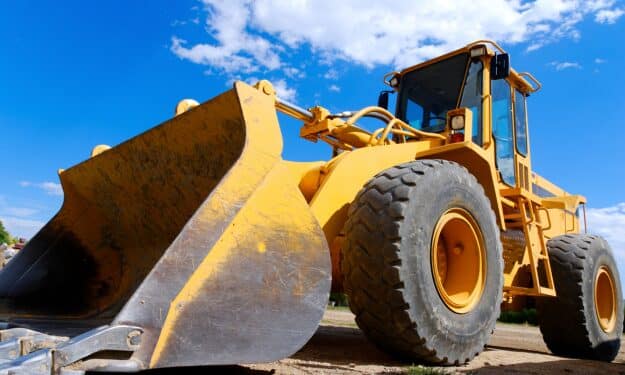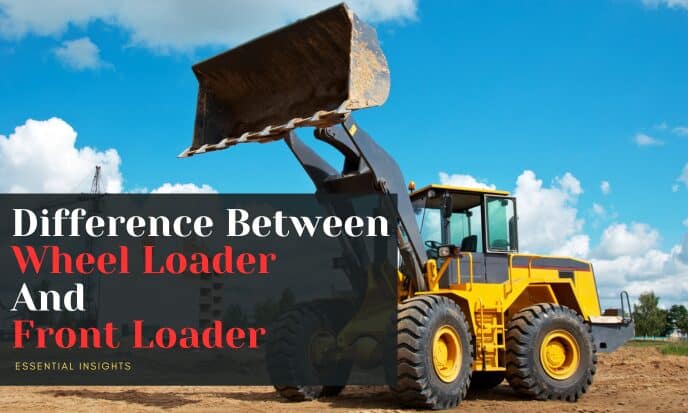A wheel loader typically has a larger capacity and is used for heavy-duty tasks, whereas a front loader is generally smaller and often seen on backhoes or tractors. Wheel loaders and front loaders serve distinct purposes in material handling and construction.
Understanding the differences between wheel and front loaders is crucial for adequately applying them in construction and farming tasks.
Wheel loaders, sometimes called bucket or front-end loaders, are workhorses in large-scale operations. They shine in scenarios requiring the movement of large volumes of material like earth, sand, or gravel.
Table of Contents
Their design includes:
- A large bucket at the front with substantial operating weight and horsepower.
- Making them ideal for mining.
- Quarrying.
- Heavy construction.
Front loaders are typically attached to tractors and backhoes, making them perfect for agricultural or smaller construction projects that require versatility. Their more compact design allows for precision and maneuverability rather than brute strength.
Similarly, Ilhan is ideal for tasks that demand pinpoint accuracy and ease of movement over sheer power.
What Is A Wheel Loader?
Understanding construction machinery is crucial for efficient project management.
Knowing what a wheel loader offers can guide you in choosing the right equipment. Let’s delve into what a wheel loader is and its distinct features.
Definition
A wheel loader is a heavy machine used in construction. It moves materials like soil, sand, and gravel. A large, wheeled base and a wide bucket at the front define it.
Features
Wheel loaders come with a set of identifying features:
- Articulated Steering: This allows sharp turns and better maneuverability.
- Four-Wheel Drive: Provides traction on rugged terrain.
- Various Attachments: Buckets and forks expand their use.
- Big Load Capacity: They can lift and move heavy loads with ease.
- Operator Comfort: Modern cabins offer safety and comfort for the operator.
These features enable wheel loaders to handle diverse jobs efficiently. Whether moving earth or loading trucks, a wheel loader is up to the task. For those in the market, finding wheel loaders for sale can be a smart investment in their projects.
What Is A Front Loader?

Understanding the machinery in the construction and farming industries is essential. The front loader stands as a key player. Often confused with a wheel loader, a front loader shines uniquely. Let’s explore the definition and features of a front loader.
Definition
A front loader is a type of heavy-duty equipment used to move or lift soil, sand, or debris. It mounts on the front of a tractor or truck chassis.
Features
- Hydraulic Arms: They provide lifting power.
- Bucket Attachment: This is for scooping materials.
- Versatile: It works in different settings.
- Maneuverable: Easy to operate in tight spaces.
- Compact Size: Fits smaller job sites.
Finding a front loader for sale can open up a world of productivity. It’s a valuable tool for many tasks.
Differences In Design
Exploring the differences between wheel loaders and front loaders unveils distinct design elements. Each loader type serves its purpose with unique features. Understanding these differences helps in selecting the correct loader for specific tasks.
Size And Configuration
Wheel loaders and front loaders differ notably in size and build. Wheel loaders are more extensive and come with an articulated steering system. This system allows the rear wheels to move independently, aiding in maneuverability.
In contrast, front loaders are generally more compact. They lack the articulated steering of wheel loaders. Their design focuses on stability and lifting strength.
Tires Vs. Tracks
The choice between tires and tracks significantly impacts loader performance. Wheel loaders typically ride on large, rugged tires, which provide speed and flexibility on varied terrains.
Front loaders, on the other hand, might feature tracks. Tracks offer superior traction over soft or uneven surfaces. They spread the machine’s weight, reducing ground pressure.
Functional Differences
Understanding how a wheel loader differs from a front loader helps select the right equipment. These machines may look alike but have distinct functions. Let’s explore the key functional differences between them.
Primary Use
A wheel loader is versatile and designed for multiple tasks like scooping, lifting, and transporting materials. It works well in diverse environments, from construction sites to farming.
A front loader, on the other hand, is often seen attached to a tractor. It focuses mainly on lifting and moving materials such as soil or hay.
Lifting Capacity
The lifting capacity of these loaders varies significantly. Wheel loaders typically handle heavier loads and are equipped for intense construction work. Front loaders are better for lighter, more precise tasks on farms and small work sites.
Travelling Speed
With traveling speed, wheel loaders outpace front loaders, which is ideal for jobs requiring movement over larger areas. Front loaders, being more compact, are slower but excel in tight spaces where precision matters more than speed.
Choosing between the two loaders depends on the job’s specific requirements — from the weight of materials to the size of the site and the need for mobility.
Applications
Exploring the world of heavy machinery, one might come across various powerful beasts. Two such machines that often create confusion are wheel loaders and front loaders. Both carry out heavy tasks but serve different purposes. Understanding their applications is crucial in determining the proper beast for the job.
Let’s delve into the specific uses each one excels in across different industries.
Construction Industry
Machines that offer versatility and strength are integral to success in the fast-paced construction sector.
Wheel loaders and front loaders have distinct roles to fill here:
- Wheel Loaders are ideal for moving large amounts of materials like sand, gravel, or debris across construction sites. Their mobility and speed are essential for site efficiency.
- Front Loaders: These are often attached to tractors and used for more precise tasks. Smaller in scale, they handle tasks like digging and lifting specific materials.
Agriculture
In the realm of agriculture, these loaders become a farmer’s right-hand machinery, each one serving a vital role:
- Wheel Loaders: They tackle heavy-duty jobs like moving large hay bales and contribute to feeding and clearing operations on a larger scale.
- Front Loaders: Perfect for daily farm activities, they easily scoop feed, manure, and other materials, enhancing farm management efficiency.
Mining
Mining demands equipment that is robust and reliable. In such a challenging environment, loaders need to perform consistently:
- Wheel Loaders: With their high-capacity buckets, wheel loaders move ore and minerals. They are quick and flexible, essential for surface mining operations.
- Front Loaders: They are handy for more precision-based tasks. Front-loaders often work in closer quarters to manage material sorting and transport.
Considerations For Choosing
Choosing the right equipment is key to efficiency on a worksite. The decision between a wheel loader and a front loader requires careful consideration. Below are vital factors to consider.
Job Requirements
Understanding the job at hand is crucial.
- The size and type of material to be moved influence the choice.
- Loaders vary in lifting capacity and bucket size, matching different workloads and functions.
- Attachment compatibility determines versatility for various tasks.
Terrain
Terrain affects loader performance.
- Wheel loaders excel on hard, flat surfaces.
- Front-loaders might perform better on uneven ground.
- Tire and track options need consideration for rough terrain.
Budget
Cost influences buying or renting decisions.
| Expense Type | Wheel Loader | Front Loader |
| Initial Purchase | Higher | Lower |
| Maintenance | Variable | Variable |
| Fuel Efficiency | Depends on model | Depends on model |
Consider the long-term value and cost of ownership.
- Compare the total cost of operations over time.
- Evaluate potential resale value for both types.
Frequently Asked Questions Of Wheel Loader VS Front Loader
What Is A Wheel Loader Used For?
A wheel loader is a heavy equipment machine often used in construction to move or load materials such as asphalt, demolition debris, dirt, snow, feed, gravel, logs, raw minerals, recycled material, rock, sand, woodchips, etc.
Its versatility makes it indispensable on many job sites.
How Does A Front Loader Differ From a Wheel Loader?
A front loader, typically referred to as a front-end loader or bucket loader, is a type of wheel loader.
However, usage context differs as “front loader” often describes smaller, residential machines, whereas “wheel loader” may imply larger, industrial-sized equipment suitable for heavy construction.
Can A Wheel Loader Be Used For Excavation?
While wheel loaders can perform light excavation tasks and are adept at scooping and moving material, they are not primarily designed for deep excavation like backhoes or excavators due to their bucket shape and machine configuration, which is tuned more towards lifting and loading.
What Bucket Capacity Does A Front Loader Have?
Front-loaders come with varying bucket capacities designed for different tasks. Residential models typically have smaller capacities, ranging from 0. 5 to 2 cubic yards.
Industrial wheel loaders have much larger buckets, with capacities exceeding five cubic yards for heavy-duty jobs.
Conclusion
Understanding the distinct roles of wheel and front loaders optimizes your project’s efficiency. Both machines excel in their terrain, with wheel loaders offering mobility and front loaders excelling in precision tasks.
Choose wisely for your construction needs, ensuring the right equipment drives your productivity forward.





